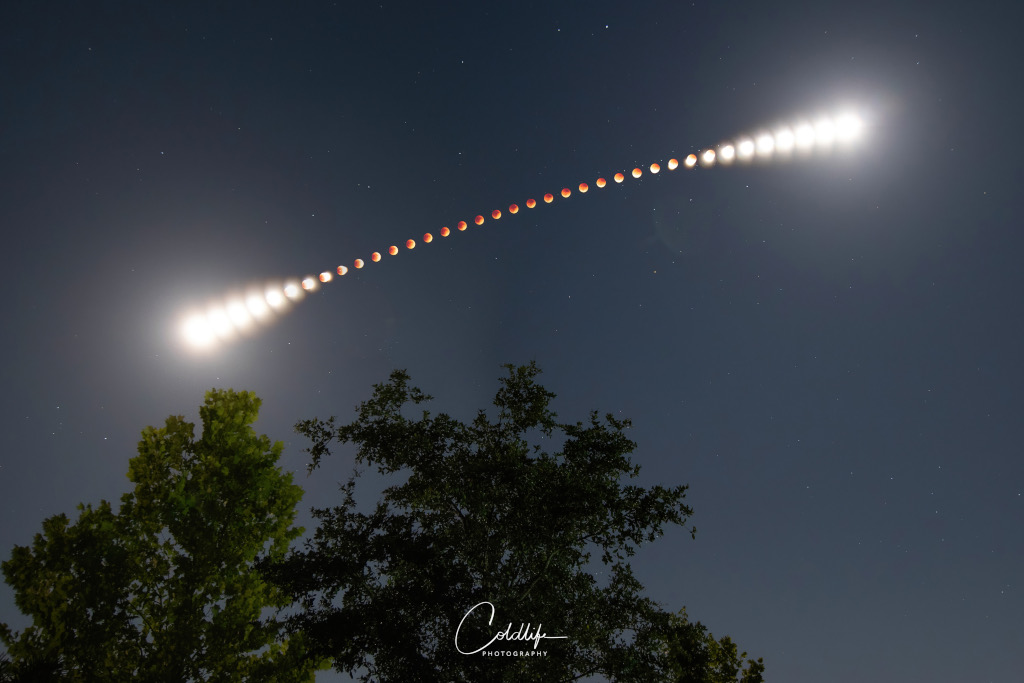19. May 2022
數位 kha-mé-lah 翕著 ê 月食

探索宇宙1!逐工會揀一幅無仝款 ê 影像抑是相片,𤆬你熟似咱這个迷人 ê 宇宙,閣有專業天文學者2為你3解說4。
- 原始文章:A Digital Lunar Eclipse
- 影像來源 kah 版權:Michael Cain
- 台文翻譯:An-Li Tsai (NCU)
[漢羅] 數位 kha-mé-lah 翕著 ê 月食
5 月 15 到 16 這暗,美國 Florida 州中部 ê 天氣算袂䆀。 這个樹仔頂 ê 光點弧,就是咧記錄月圓 拄著 月全食 ê 系列變化。 有一台數位 kha-mé-lah 每 5 分鐘翕一擺,予咱會當看著月食 tī 3 點鐘內 ê 變化過程。 月球 趨 tùi 地球烏影 ê 時陣,月盤就變暗、變紅矣。 講實在--ê,咱若是算看覓這个系列相片 ê 中央有幾粒月球,就會知影月全食 tī 規个月食過程,佔差不多 90 分鐘 ê 時間。 西元前 270 年左右,希臘天文學家 Aristarchus 嘛量過月全食愛經過偌濟時間。 應該是 無通用 電子錶抑是數位 kha-mé-lah 啦! 毋閣伊猶是用 幾何學 ê 方式,利用月食經過 ê 時間 kah 地球 半徑 ê 大細,簡單閣精確 算出月球 ê 距離。
[POJ] Sò͘-ūi kha-mé-lah hip tio̍h ê Goe̍h-si̍t
5 goe̍h 15 kàu 16 chit àm, Bí-kok Florida chiu tiong-pō͘ ê thiⁿ-khì sǹg bōe-bái. Chit ê chhiū-á téng ê kng-tiám hô͘, tō-sī leh kì-lo̍k goe̍h-îⁿ tú-tio̍h goe̍h-choân-si̍t ê hē-lia̍t piàn-hòa. Ū chi̍t tâi sò͘-ūi kha-mé-lah múi 5 hun-cheng hip chi̍t tiuⁿ, hō͘ lán ē-tàng khòaⁿ-tio̍h goe̍h-si̍t tī 3 tiám-cheng lāi ê piàn-hòa kòe-têng. Goe̍h-kiû chhu tùi Tē-kiû o͘-iáⁿ ê sî-chūn, goe̍h-pôaⁿ tō piàn àm, piàn âng ah. Kóng si̍t-chāi--ê, lán nā-sī sǹg khòaⁿ-māi chit ê hē-lia̍t siòng-phìⁿ ê tiong-ng ū kúi lia̍p goe̍h-kiû, tō ē chai-iáⁿ goe̍h-choân-si̍t tī kui ê goe̍h-si̍t kòe-têng, chiàmf chha-put-to 90 hun-cheng ê sî-kan. Se-goân chêng 270 nî chó-iū, Hi-la̍h thian-bûn-ha̍k-ka Aristarchus mā niû kòe goe̍h-choân-si̍t ài kéng-kòe gōa-chōe sî-kan. Èng-kai sī bô-thang iōng tiān-chú-pió ia̍h-sī sò͘-ūi kha-mé-lah la̍h! M̄-koh i iáu-sī iōng kí-hô-ha̍k ê hong-sek, lī-iōng goe̍h-si̍t kéng-kòe ê sî-kan kah Tē-kiû pòaⁿ-kèng ê tōa-sè, kán-tan koh cheng-khak sǹg-chhut Goe̍h-kiû ê kū-lî.
[KIP] Sòo-uī kha-mé-lah hip tio̍h ê Gue̍h-si̍t
5 gue̍h 15 kàu 16 tsit àm, Bí-kok Florida tsiu tiong-pōo ê thinn-khì sǹg buē-bái. Tsit ê tshiū-á tíng ê kng-tiám hôo, tō-sī leh kì-lo̍k gue̍h-înn tú-tio̍h gue̍h-tsuân-si̍t ê hē-lia̍t piàn-huà. Ū tsi̍t tâi sòo-uī kha-mé-lah muí 5 hun-tsing hip tsi̍t tiunn, hōo lán ē-tàng khuànn-tio̍h gue̍h-si̍t tī 3 tiám-tsing lāi ê piàn-huà kuè-tîng. Gue̍h-kiû tshu tuì Tē-kiû oo-iánn ê sî-tsūn, gue̍h-puânn tō piàn àm, piàn âng ah. Kóng si̍t-tsāi--ê, lán nā-sī sǹg khuànn-māi tsit ê hē-lia̍t siòng-phìnn ê tiong-ng ū kuí lia̍p gue̍h-kiû, tō ē tsai-iánn gue̍h-tsuân-si̍t tī kui ê gue̍h-si̍t kuè-tîng, chiàmf tsha-put-to 90 hun-tsing ê sî-kan. Se-guân tsîng 270 nî tsó-iū, Hi-la̍h thian-bûn-ha̍k-ka Aristarchus mā niû kuè gue̍h-tsuân-si̍t ài kíng-kuè guā-tsuē sî-kan. Ìng-kai sī bô-thang iōng tiān-tsú-pió ia̍h-sī sòo-uī kha-mé-lah la̍h! M̄-koh i iáu-sī iōng kí-hô-ha̍k ê hong-sik, lī-iōng gue̍h-si̍t kíng-kuè ê sî-kan kah Tē-kiû puànn-kìng ê tuā-sè, kán-tan koh tsing-khak sǹg-tshut Gue̍h-kiû ê kū-lî.
[English] A Digital Lunar Eclipse
Recorded on May 15/16 this sequence of exposures follows the Full Moon during a total lunar eclipse as it arcs above treetops in the clearing skies of central Florida. A frame taken every 5 minutes by a digital camera shows the progression of the eclipse over three hours. The bright lunar disk grows dark and red as it glides through planet Earth's shadow. In fact, counting the central frames in the sequence measures the roughly 90 minute duration of the total phase of this eclipse. Around 270 BC, the Greek astronomer Aristarchus also measured the duration of total lunar eclipses, but probably without the benefit of digital watches and cameras. Still, using geometry he devised a simple and impressively accurate way to calculate the Moon's distance in terms of the radius of planet Earth, from the eclipse duration.
詞彙學習
| 漢羅 | POJ | KIP | 華語 | English |
|---|---|---|---|---|
| 月食 | goe̍h-si̍t | gue̍h-si̍t | 月食 | lunar eclipse |
| 月全食 | goe̍h-choân-si̍t | gue̍h-tsuân-si̍t | 月全食 | total lunar eclipse |
| 月圓 | goe̍h-îⁿ | gue̍h-înn | 滿月 | full moon |
| 月盤 | goe̍h-pôaⁿ | gue̍h-puânn | 月盤 | lunar disk |
| 幾何學 | kí-hô-ha̍k | kí-hô-ha̍k | 幾何學 | geometry |
| 半徑 | pòaⁿ-kèng | puànn-kìng | 半徑 | radius |
| 系列 | hē-lia̍t | hē-lia̍t | 系列 | sequence |
| 希臘 | Hi-la̍h | Hi-la̍h | 希臘 | Greek |